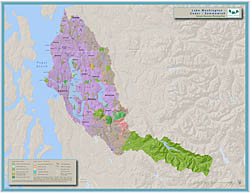 |
| |
|
|
|
|
The watershed supports populations of threatened Issaquah Creek and
Cedar River summer and fall Chinook, and threatened Chester Morse bull
trout. The watershed is also home to Coho and sockeye salmon, winter
steelhead, rainbow and coastal cutthroat trout, Issaquah Creek summer
Kokanee, and late run Lake Sammamish Kokanee. |
| |
 |
Chinook
|
 |
Bull Trout
|
 |
Coho
|
 |
Sockeye
|
 |
Steelhead
|
 |
Cutthroat
|
 |
Kokanee
|
| Salmon images courtesy of King County. Steelhead
image courtesy of National Oceanic and Atmospheric Administration/Department
of Commerce. |
| |
| How Chinook
Use the Watershed |
|
The Cedar River, Bear Creek and Issaquah Creek, along with their smaller
tributaries, are the major salmon-bearing streams within the Lake Washington
watershed. Upon emerging from the gravel, some Chinook fry remain in
fresh water for about 3-6 months, feeding on stream and terrestrial
insects. Some fry may reside in Lake Washington for 2-3 years. Smolts
migrate downstream to Puget Sound via the Ballard locks where they
feed and grow for several weeks to over a year before heading northward
to the Gulf of Alaska. |
|
|
|
 |

Lake Washington/Cedar/Sammamish Watershed
| |
For more information about salmon recovery
planning in this watershed, click here.
Click here to read
this watershed's feedback summary.
|
 |
 |
 |
 |
 |
Key
Facts |
| |
The watershed contains the
Cedar and Sammamish Rivers, and two large lakes: Lake
Washington and Lake Sammamish.
The most populous
watershed in the state, it is located mainly in King
County, with about 15% extending northward into Snohomish
County.
The planning area for the watershed under the
state Watershed Management Act is Watershed Resource
Inventory Area (WRIA) 8. |
|
| |
|
Major Policy or Actions Needed to Recover
Salmon
- Protect and enhance forest cover, water quality (particularly
from sedimentation and road runoff), headwater areas, instream
flows, wetlands, sources of cold water and riparian vegetation.
Minimize impervious surfaces and road crossings.
- Find increased
funding.
- Revise critical areas ordinances, stormwater programs,
Shoreline Master Programs, groundwater management plans and other
existing tools to achieve these actions, along with acquisitions,
incentives, public outreach, and education.
- Maintain current
urban growth boundary to protect rural habitat areas.
- Promote
low impact development in urban and rural areas to accommodate
new population, while increasing infiltration and improving flows.
- Enforce
existing and new policies and regulations consistently.
The following actions are key to supporting salmon recovery:
- Cedar
River Mainstem: Protect best remaining habitat. Setback or remove
levees, add large woody debris to create pools and plant riparian
vegetation to restore sources of large woody debris.
- Bear Creek & Cold/Cottage
Creek: Protect best remaining habitat and sources of cold water
to maintain temperature regime. Reduce sedimentation, channel
confinement and add large woody debris to create pools.
- Issaquah
Creek: Protect best remaining habitat.
Priority actions recommended for Migratory and Rearing Corridors
include:
- Lake Washington: Remove bank hardening, restore shallow water
habitats, plant over-hanging riparian vegetation and restore
or enhance small tributary mouths (particularly in South Lake Washington).
- Sammamish
River: Increase habitat diversity and reduce temperatures by
restoring channel meanders, reconnecting sources of groundwater,
side channels, wetland habitat, and enhancing sources of cooler
water in reaches nearest Lake Sammamish. Restore setback levees,
plant riparian vegetation and add large woody debris in reaches
nearest Lake Washington.
- Ship Canal/Locks: Restore shallow-water
migratory habitats, plant riparian vegetation, and investigate
ways to reduce temperatures.
- Nearshore/Estuary: Protect remaining
feeder bluffs that supply sediment and restore sediment sources;
enhance stream mouths to create pocket estuaries; protect and
restore marine riparian vegetation; and reconnect wetlands and
backshore areas.
- Lake Sammamish: Remove bank hardening, restore
shallow water habitats, plant over-hanging riparian vegetation
and restore or enhance small tributary mouths.
| We’re
Making Progress—Some Accomplishments |
Twenty-seven local governments
have been working together and cost-sharing a major planning
effort to support Chinook recovery in the watershed.
The new fish ladder at Landsburg Dam offers access to
an additional 12 miles of high quality Chinook habitat.
Fish
passage improvements at the Hiram Chittenden Locks
have vastly increased survival rates of migrating salmon.
Hundreds
of acres of habitat have been protected through Bear
Creek Waterways, Issaquah Waterways, and Cedar River
Legacy.
Low impact development demonstration projects
underway in King and Snohomish Counties will provide
valuable information on science, marketing, costs,
and public response.
Basin stewards work with community
groups and private landowners to foster a culture of
stewardship.
|
|
Organizations Involved
- Town of Beaux Arts Village
- City of Bellevue
- City of Bothell
- City of Clyde Hill
- City of Edmonds
- Town of Hunts Point
- City of Issaquah
- City of Kenmore
- City of Kent
- King County
- City of Kirkland
- City of Lake Forest Park
- City of Maple Valley
- City of Medina
- City of Mercer Island
- City of Mill Creek
- City of Mountlake Terrace
- City of Mukilteo
- City of Newcastle
- City of Redmond
- City of Renton
- City of Sammamish
- City of Seattle
- City of Shoreline
- Snohomish County
- City of Woodinville
- Town of Yarrow Point
Also includes citizens, scientists, and representatives from key
business and community groups, state agencies, and the Army Corps
of Engineers.
Back to Top | Back
to Watershed Profiles
|


